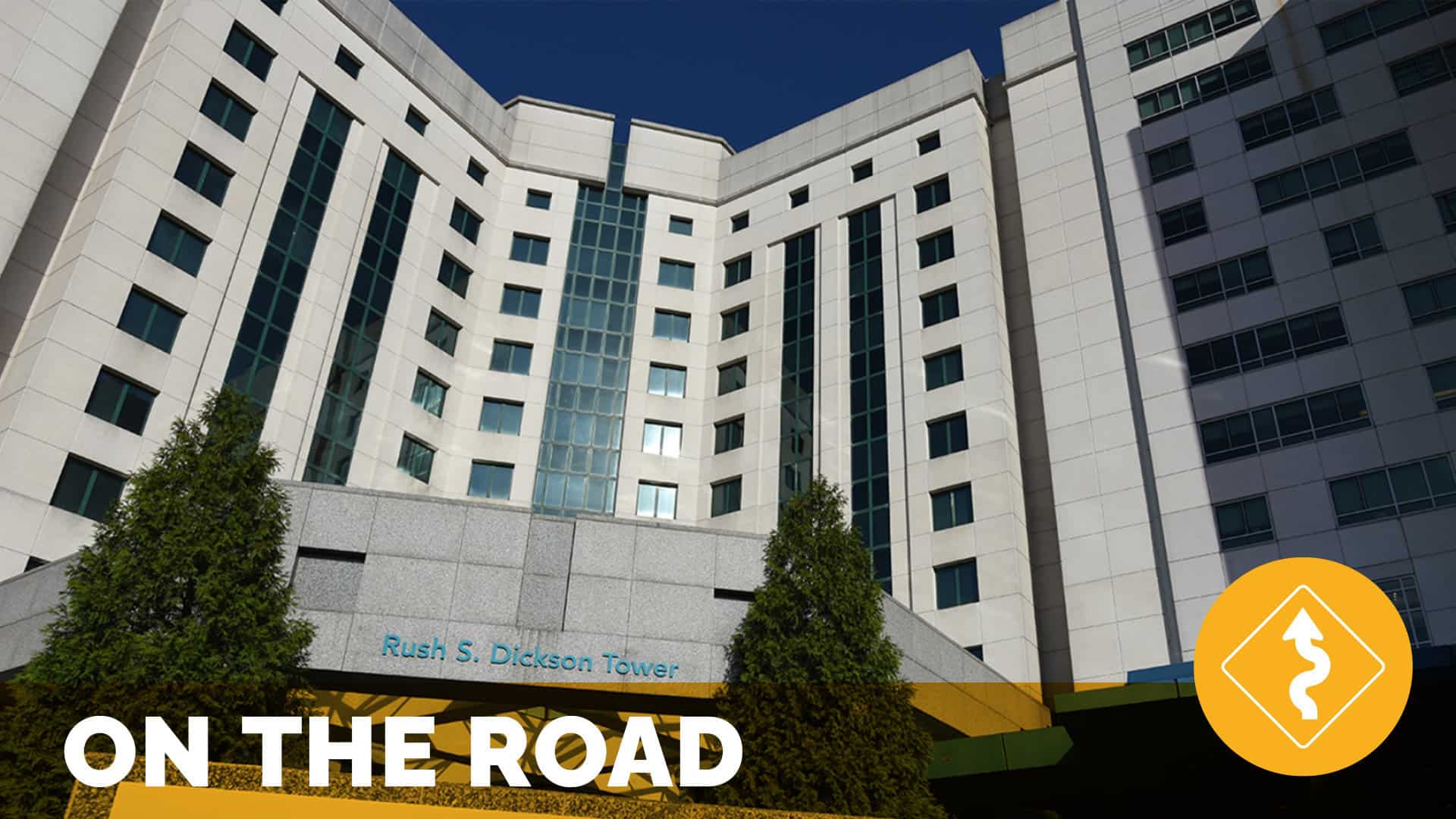An Integrated Approach to Patient Experience Performance

On the Road with Carolinas HealthCare System – July 2014
by Jason A. Wolf, Ph.D.
Our latest On the Road took us from last month’s look at the power of intention at a visionary community hospital to one of the most comprehensive integrated patient experience efforts I have had the chance to encounter. My visit to Carolinas HealthCare System, and its focus on “One Experience,” provides a significant model for a broad and all encompassing culture of experience. While a day could not possibly honor the extent of the work taking place at Carolinas, we covered significant ground in exploring the true ability to address patient experience across the entire continuum of care, not as disparate efforts, but as one approach for improvement and excellence.
The visit was grounded on the foundations of the Carolinas approach and then took me on a journey across the continuum – from bringing care directly to the community through satellite emergency departments (EDs), to streamlining experience in physician practice, to understanding the value of personal touch in specialty areas (in this case, the cancer setting) and to seeing efforts in acute care and post-acute care. Throughout this collection of individual sites and focus areas, one thing remained true – in fact “one” is the operative word. Carolinas HealthCare System’s “One Experience” is the foundation on which each effort is aligned and built.
A Foundation for Success – One Experience
My visit was framed by time spent with the core patient experience team led by Connie Bonebrake, SVP & Chief Patient Experience Officer, and a focused team of individuals committed to tackling the various issues driving patient experience efforts at Carolinas. With a line of sight to people and culture, metrics and engagement and data and outcomes, the team has developed a strategy that encompasses a broad reach in impacting many areas in the organization. It has also done so by bringing voices from all aspects of the system to engage in the conversations driving patient experience performance.
The center of the team’s effort stems from the system’s broader brand focus on “One” and led to the statement of “One Experience” for the organization. The idea of “One Experience” is a focus on “every person, every encounter, every time,” shared Connie Bonebrake in introducing the strategy. “It is a plan grounded in our broader organizational commitment to be recognized nationally as a leader in the transformation of healthcare delivery and to ensure we are chosen for the quality and value of services we provide,” she added.
This vision is a powerful foundation on which the patient experience efforts at Carolinas are built. I also note the significance of “choice,” a word we mention often at The Beryl Institute about both the most powerful tool we have in patient experience improvement – a choice at every point of interaction – and the reality of the new healthcare marketplace – that patients are making choices as consumers of care in ways they never have before.
The core of this strategy is again a grounding in the system’s own commitment to develop enduring relationships with those they serve. This is a powerful brand statement about driving not only choice, but also loyalty. This focus also has Carolinas building its efforts firmly on its own definition of patient experience. At The Beryl Institute, we too believe that definition predicates true action. For without a focus, in what direction are you headed? The team at Carolinas put a thoughtful personalized spin (based on The Beryl Institute’s community definition) in defining what patient experience would be for the system. They define patient experience as:
The sum of all interactions, shaped by the One culture of Carolinas HealthCare System, that influences patient perceptions across and at each point of the continuum of care.
The definition and aligned strategic focus has allowed Carolinas to design and act on a broader integrated experience effort. One grounded in four key areas: Foundations of Caring, Healing Environments, Teammate Engagement and V.O.I.C.E. (Values, Opinions, Information, Collaboration, and Engagement). Each of these points of focus has specific actions, practices and processes associated with them. This is a well thought out model for aligning effort and ensures a strategic focus on actions across the system in addressing patient experience overall.
What the patient experience team shared reinforced a belief central to patient experience performance excellence. That in having a clear strategic focus and a shared model on which to build actions, you can truly drive system level outcomes. The “One Experience” model does just that. In asking the team for some of its keys to success, they identified a combination of the willingness to make this a priority and provide the infrastructure of support, a clear direction and purpose framing the effort and then the commitment of people at all levels throughout the system that help to drive outcomes. It is truly a systemic approach.
Building on this extensive framing, my host and guide for the day, Patrick Ratchford, VP Patient Experience, and the rest of the team took me on a journey across the continuum of care to see these ideas in action.
One Experience in Practice
As I noted above, a day could never do full justice to the extensive nature of the effort taking place at Carolinas, but what I had the chance to see was a truly integrated effort at creating “One Experience.” The various stops we made offered a perspective on the overall care experience, and I will share a few highlights from each location visited and idea explored during the journey.
Patient Experience in a Satellite ED Setting
One of the aspects of building relationships and engaging the community was to bring the care experience out of the traditional hospital setting and make care more accessible regionally. Through the use of local satellite EDs, Carolinas has been able to expand its reach as a community care provider. In particular, I visited Carolinas HealthCare System SouthPark, a brand new facility that was designed with the patient in mind, from creating ease in access to an environment not only patient-friendly, but also family friendly. The facility was designed to manage all but the most critical of issues.
Behind the facility was a lean design plan that incorporated considerations about process as well as environment and a patient centered focus. Actual mock-ups of the facility were created so input could be gathered from all constituents in the process. You could sense great pride in the physicians, nurses and team members who helped design a facility that would enable the best in experience from the outset.
PX in physician practices: Power of physician engagement in driving outcomes
From the urgent setting of the ED, we then spent time with the leadership of one of Carolinas HealthCare System’s more visionary physician practice groups, the Sanger Heart & Vascular Institute (Sanger). In my visit with the team, the commitment to effective process and patient experience focus was evident and as they shared their stories, the commitment to “One Experience” was unmistakable.
We covered a series of efforts that exemplified the committed focus at Sanger, one around physician engagement and one on the access process, specifically on shared medical appointments. In addressing physician engagement efforts, Sanger focused on four key areas. The first, putting in place an extensive learning and support resource to provide the needed information to guide actions.
This was supplemented by the second item, and a cornerstone of the effort, putting provider champions in place to support and influence the efforts. Champions are used to disseminate awareness and reinforce the “why” experience is important, extend the reach of accountability to the front lines of care and serve in some way as a motivator/expert resource in helping others to work towards greater strength in providing the best experience. The champion program was augmented by 1 on 1 coaching that enabled providers to understand strengths and weaknesses, address key issues and sure up opportunities for improvement. These individuals saw great value in the program and, in fact in areas where coaching took place, measurable increases could be found on survey results. The final component of the work was intensive skills training, in particular around emotional intelligence, to enhance personal strengths and relationship building overall in the care encounter.
Complimenting this effort was an intentional focus on driving physician engagement. As a recognized opportunity for the clinic, they set out on an intentional effort to work with leaders at all levels to build a plan for engagement, leadership development and an expanded sense of ownership for overall outcomes. This effort has led to significant improvements in clinic outcomes overall. Major efforts were undertaken on understanding team performance issues and addressing and resolving them. The other was on creating a shared vision for what they hope to accomplish. This focus on engagement has also led to some tangible results. As physician engagement has increased there has been a parallel measurable increase in patient satisfaction. The story of Sanger’s journey helps reinforce the power of taking care of our people to ensure the best for those we serve. It also makes the point that this is not just about front line caregivers or staff, but if we consider the right things and engage our physicians in the right way, they too become levers for greater success in clinical and service outcomes overall.
One of the practices Sanger put into place to address the process side of experience was around a focus on access and the ideas of shared medical appointments and virtual visits. The practice now has the ability to bring in multiple patients with the same illnesses for what equates to a group learning session with individual assessment opportunities. Via group appointment, patients actually get more time exposed to key caregivers, get an instant support group and have expanded opportunities for learning about their own health issues. In this setting as well, it changes the engagement of physician and patient to a short segment of time to a more valuable interaction with the care team overall. Virtual appointments also serve as a powerful access option, by allowing “home” visits, monitoring and follow-up via web and video connections. This has enabled more responsiveness, ease of use and the ability to tackle adherence, understanding of care plans and impacts potential readmissions as well.
The innovations found in the practice area of Carolinas, exemplified by the leading work of Sanger, provides an additional insight into how a unified effort can be adapted to fit the respective areas of the care continuum and still honor the broader commitment to experience overall. Sanger’s efforts show us the power of engagement, development, accountability and innovation and how these can play out in driving the best in experience overall.
The impact of experience on the enterprise: A focus on specialty care
The efforts in the clinic space were also seen in the specialty care areas of Carolinas HealthCare System and in particularly were evident during my visit to Levine Cancer Institute (LCI). The focus on the patient in this setting was unquestionable from the moment I arrived at the facility and was greeted by valets, volunteer greeters and others ensuring I had what I needed from the moment I arrived to the extensive personal touches in creating the best in healing environments through resources, amenities and support.
This is not to say other cancer care facilities do not have similar offerings, but what stood out here was LCI’s alignment to the broader efforts of Carolinas. LCI, as did the many other parts of the system I visited, worked on its own experience focus driven by its vision – changing the course of cancer care. Focusing its effort on the four elements of the Carolinas HealthCare System Patient Experience Model, LCI took its own journey to determine direction and align staff on what it meant to be patient-centric.
This effort has led to a very clear purpose of engaging the community, ensuring inclusive decision making, communicating broadly, using data to drive change and aligning work with the system overall. Again LCI exemplified the ability to make your own, what is driven systemically and still honor the framework in which it is held. The work of LCI continues beyond the incredible facility, to the intensity, focus and pride with which the team engages in its patient centered efforts. It is seen in the very way they talk about and act on how they care for and treat the people who enter its doors every day.
Working on the core: Key elements influencing acute care
As we expand the patient experience conversation at The Beryl Institute to the full reach of the care continuum, it was incredible to touch on all aspects of care at Carolinas. This included the core of its work ensuring the best in experience in acute locations. I had the chance to visit two facilities, Carolinas Medical Center (CMC) and CMC-Mercy, to see their efforts at work. During these visits we didn’t talk about the general tactics to drive experience success, much of what is included in the “One Experience” model, but rather explored some of the additional areas of focus helping to reinforce the experience effort overall. This included the exploration of patient and family voice and the use of interactive technology as well as the spiritual and environmental elements of care.
I had the privilege of having lunch with a number of representatives from Carolinas HealthCare System’s Patient and Family Advisory Councils. The point here being not that Carolinas has advisors, as many organizations do. Rather what was shared was how they use advisors, actively listen and drive change. Hearing the personal stories of these individuals, some positive and some not, you got the sense they understood that Carolinas HealthCare System not only wanted to hear their voice, but also was taking critical steps to act on them. As one participant shared, “I am amazed by what a single voice can do.” To me, this exemplified the very power of “One” at the center of the Carolinas brand and experience focus. They did not just act at the level of one integrated system, providing one experience (aligned with the needs of the patients they are serving); each and every voice in the system, from patients and family members to associates and staff, is the very essence of one voice adding value through their ideas and input.
This was reinforced in my conversation with David Carl, Executive Director of Spiritual Care and Education. He acknowledged the power of individual experience and voice and how spirituality played an important role in reinforcing the humanity of all working in or touched by Carolinas HealthCare System. David shared four key points of focus in how Carolinas was striving to provide the best in healing environments. He talked about the physical space in which care is delivered, creating healing spaces and environmental support for the care process; the interpersonal, focusing on the power of interactions and how people choose to treat one another; the intrapersonal, focusing on the importance of self care and compassion; and the extrapersonal, the ability to reach beyond yourself to inspired and be inspired. This powerful framing helps to reignite passion and reinforce the core humanity that is part of Carolinas mission to provide one experience. (You can learn more about the Carolinas effort and hear from David directly on a webinar he is offering via The Beryl Institute August 5th).
My visit to the acute setting also showed how the team was looking to engage the whole person through the use of interactive technology, a growing means to educate, inform, entertain and connect with patients and how they are using this technology platform to help create a more personalized and productive experience. I continue to believe there is great value in the application of some sort of interactive platform and see these systems in many of the forward thinking healthcare organizations looking for new ways to provide much more than an amenity. They use this technology for connection, personalization, quality and responsiveness and the data continue to grow in linking the use of these technology tools to better survey outcomes and experiences overall.
My acute site visit then moved to CMC-Mercy which exemplified the strongly aligned, yet adaptive power of “One Experience.” CMC-Mercy is a designated Planetree Facility and exemplified how the principals put in place to ensure designation only served to reinforce the core of the Carolinas experience overall. To the clear focus on environment of care, the means for engaging patient and family voice and the engagement of key staff, CMC-Mercy exemplified the way in which the “One Experience” idea isn’t driven on replicating a specific “way” of doing thing, but rather reinforces the focus, intention and actions that are central to the experience Carolinas wants all in its environment to experience.
Patient experience in continuing care: Extending efforts to the post-acute setting
From the acute environment, we took one more step across the continuum during my visit to an area of expanding interest and work at The Beryl Institute as well – continuing care, the post-acute and long-term care settings. There was powerful work being done at one facility in particular: Huntersville Oaks. The reality of the “One Experience” model and the focus on a truly integrated system of care may have been no better exemplified that in my final stop for the day.
Huntersville Oaks encompasses a rehabilitation facility, a residential facility and a focus on dementia all under one roof and represents what I see to be a trend in creating experiential environments for residents in the long-term care environment.
From the presence of neighborhoods, with community centers/dens and dining areas and a “Main Street” with a store, café and salon, the facility physically worked to create a warm and comfortable environment of care. But that is just the foundation on the efforts. What the Huntersville Oaks team shared was the broader effort being implemented across the continuing care settings in Carolinas HealthCare System. From an unwavering focus on the “One Experience” model, there was a clear commitment to gathering and listening to patient and teammate voices. Stories of success are gathered and shared widely and a growing number of Patient/Resident/Family Advisory Councils are being established.
This outreach and focus on “One Experience” and its core ideas reached beyond the residential environments to touch those receiving care in Skilled Nursing Facilities, via Home Care and in Palliative and Hospice Care as well. What was significant was the importance of these same core ideas of driving a positive experience at this end of the care continuum – that in providing the best in experience across the various aspects of continuing care they support and reinforce Carolinas HealthCare System’s commitment to “One.” The team shared its true focus on experience in the excitement they put into Patient Experience Week 2014 as well. The energy, passion and focus exemplified in the actions of the individuals in this environment was clear and showed how Carolinas was truly committed to “One Experience” all at touch points on the continuum of care. They were truly living their definition of the patient experience – every person, every encounter, every time.
The Foundation of Success
As we wrapped up the day, I had a chance to reconnect with Connie Bonebrake at Huntersville Oaks where she shared a powerful statement about what the “One Experience” model was truly built on. As the team in the room offered these ideas, I could recall multiple moments along the journey we took across the continuum where this rang true. The ability to deliver “One Experience” is about the relationships created with one another and those in our care, it is about listening to all voices and acting on what is learned in the process, it is about the recognition that patient experience is not an additional thing, but rather the given of what you do each and every day in healthcare across all settings and across all roles.
Cheryl Snellgrove, Person Centered Care Mentor, shared, “In the end, we are people caring for people,” and Connie shared a video that reflected the range of people that comprise Carolinas HealthCare System. The diversity of backgrounds, educations and experiences that make up a healthcare system is truly incredible and what Connie was reinforcing above all else was that the ability to drive and sustain “One Experience” is through the people of the organization itself. I consistently say, and saw reinforced on this visit, that at the core of patient experience are the interactions we create, support and sustain and that our primary means of delivering that interaction is from one human being to another. By creating a model of “One” at Carolinas, they actually created the space for the voices of many to lead, heal, learn, care and listen in every moment in ensuring the best in experience for all.
My deepest thanks to the entire Carolinas team for a full and broad journey across the continuum of care, through “One Experience”, and to all those along the visit who exemplified the passion, purpose and commitment that still make what we do in healthcare one of the most incredible contributions to one another.
Related content
-
 Infrastructure & Governance | Staff & Provider Engagement
Infrastructure & Governance | Staff & Provider EngagementIs There a Doctor in the House? The Benefits of Partnering a Physician with Patient Advocacy
Wondering how to take your Patient Advocacy team to the next level? This webinar will walk through the advantages of having a physician champion working closely with your advocacy team. We will cover physician engagement, clinical oversight, quality review, and key concepts that make for a successful physician partnership. Presenters will share their journey of
Learn more -
 Infrastructure & Governance
Infrastructure & GovernanceStrategic Psychological Behaviors to Enhance Patient Experience
Learn how transform healthcare by infusing human-centered design and evidence-based methods into operations with strategic and consistent psychological behaviors to enhance patient and employee expectation, perception and experience.
Learn more -
 Infrastructure & Governance
Infrastructure & GovernanceStorytelling at board meetings: A case study of co-developing recommendations
In healthcare, stories shared by patients often provide details and insights into experiences of illness and care. Stories are a way to educate healthcare providers and others to improve care and systems to become more patient and family centred and to better meet patients’ needs and priorities. Telling stories may bring benefits to both storytellers
Learn more
